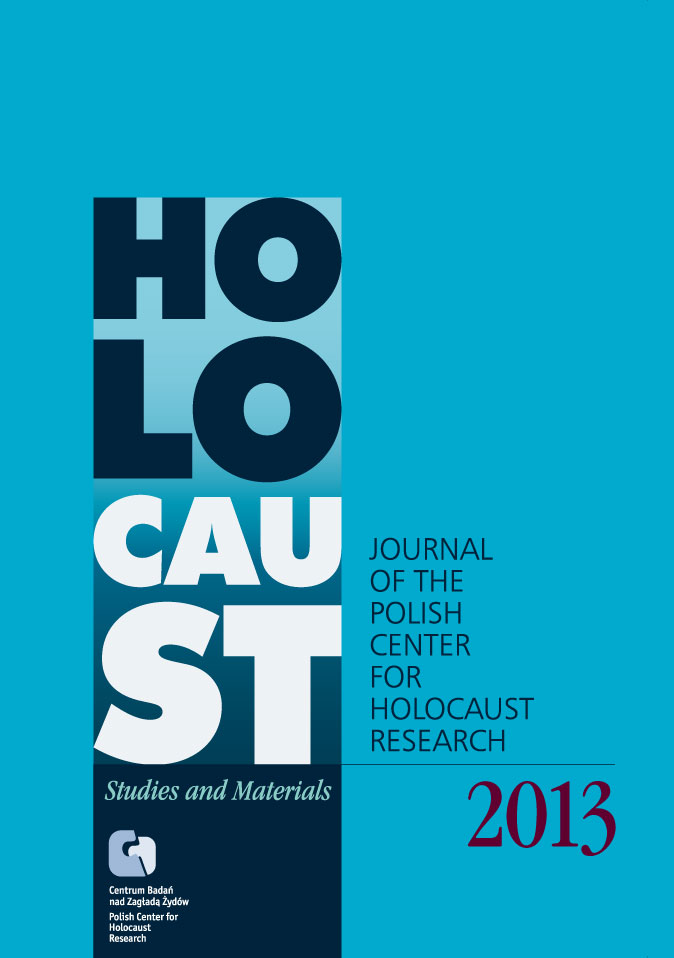Polish Help to Jews in the Countryside during the German Occupation. A Sketch Using the Example of the Righteous among the Nations
Zagłada Żydów. Studia i Materiały, Nr Holocaust Studies and Materials (2013), Strony: 122-158
Data zgłoszenia: 2020-12-13Data publikacji: 2013-02-20
 https://doi.org/10.32927/zzsim.797
https://doi.org/10.32927/zzsim.797
Abstrakt
The author analyzes help by Poles decorated with the Righteous among the Nations medal to Jews hiding in the countryside during the Nazi occupation. The author demonstrates that stories told many years later differ from immediate post-war recollections. A statistical analysis of the extensive material yields information on the various regularities related to help in rural areas: that the scale of help depends on the integration of the Jews with the Polish society, that they most often sought help close to their places of residence, that help came more frequently form the peasants than from the educated village dwellers, and that the greatest threat to the helpers were their own neighbors.
Licencja
Prawa autorskie (c) 2013 Autor & "Zagłada Żydów. Studia i Materiały"

Utwór dostępny jest na licencji Creative Commons Uznanie autorstwa 4.0 Międzynarodowe.
https://creativecommons.org/licenses/by/4.0
Inne teksty tego samego autora
- Zuzanna Schnepf-Kołacz, Losy pracowników niemieckiej gadzinówki „Nowy Kurier Warszawski” w świetle powojennych procesów z dekretu sierpniowego , Zagłada Żydów. Studia i Materiały: Nr 2 (2006)
- Zuzanna Schnepf-Kołacz, In a Ciechania presbytery The story of saving Zofia Trembska. A case study , Zagłada Żydów. Studia i Materiały: 2010: Holocaust Studies and Materials
- Zuzanna Schnepf-Kołacz, „Na ciechańskiej plebanii”. Historia ocalenia Zofii Trembskiej. Studium przypadku , Zagłada Żydów. Studia i Materiały: Nr 6 (2010)
- Zuzanna Schnepf-Kołacz, Włoski ogród historii. Rzym, Ferrara, Mediolan – nowe projekty na mapie żydowskich muzeów we Włoszech , Zagłada Żydów. Studia i Materiały: Nr 9 (2013)
- Zuzanna Schnepf-Kołacz, „Write your story” – seria wydawnicza Makor Jewish Community Library , Zagłada Żydów. Studia i Materiały: Nr 3 (2007)
Podobne artykuły
- Tomasz Łysak, Yolocaust: kapitalizm platform a cyfrowe praktyki upamiętniania Zagłady , Zagłada Żydów. Studia i Materiały: Nr 17 (2021)
- Anna Ziębińska-Witek, Kicz i Holokaust, czyli pedagogiczny wymiar ekspozycji muzealnych , Zagłada Żydów. Studia i Materiały: Nr 6 (2010)
- Marta Woźniak, „A ziemia się jeszcze ruszała...” Masakra Żydów w Szczeglacinie w relacjach świadków , Zagłada Żydów. Studia i Materiały: Nr 6 (2010)
- Tadeusz Bartoś, Szoa – nowe stworzenie. Metafizyka zła , Zagłada Żydów. Studia i Materiały: Nr 9 (2013)
- Krzysztof Bielawski, „Nawet umarłym nie dali spokoju”. Destrukcja cmentarzy żydowskich na terenach obecnej Polski w latach 1933–1945 , Zagłada Żydów. Studia i Materiały: Nr 15 (2019)
- Daniel Logemman, Franziska Bruder, Das eigene Schicksal selbst bestimmen. Fluchten von Juden aus den Deportationszügen in die Vernichtungslager der „Aktion Reinhardt” in Polen [Daniel Logemann] , Zagłada Żydów. Studia i Materiały: Nr 17 (2021)
- Laurent Joly, Antysemityzm i denuncjowanie Żydów we Francji podczas drugiej wojny światowej , Zagłada Żydów. Studia i Materiały: Nr 7 (2011)
- Marta Zawodna, O porządkowaniu poobozowego świata. Sposoby postępowania ze szczątkami ludzkimi na terenach byłego KL Auschwitz-Birkenau od momentu ostatecznej ewakuacji obozu do powstania muzeum , Zagłada Żydów. Studia i Materiały: Nr 8 (2012)
- Grzegorz Motyka, Przyczynek do historii PPR. Na marginesie książki Piotra Huberta Gontarczyka, Polska Partia Robotnicza. Droga do władzy , Zagłada Żydów. Studia i Materiały: Nr 4 (2008)
- Dionizjusz Czubala, Pamięć Zagłady w narracji folklorystycznej , Zagłada Żydów. Studia i Materiały: Nr 13 (2017)
<< < 36 37 38 39 40 41 42 43 44 45 46 47 48 49 50 51 52 53 54 55 56 57 58 59 60 61 62 63 64 65 66 67 68 69 70 71 72 73 74 75 76 77 78 79 80 > >>
Możesz również Rozpocznij zaawansowane wyszukiwanie podobieństw dla tego artykułu.
 English
English
 Język Polski
Język Polski








